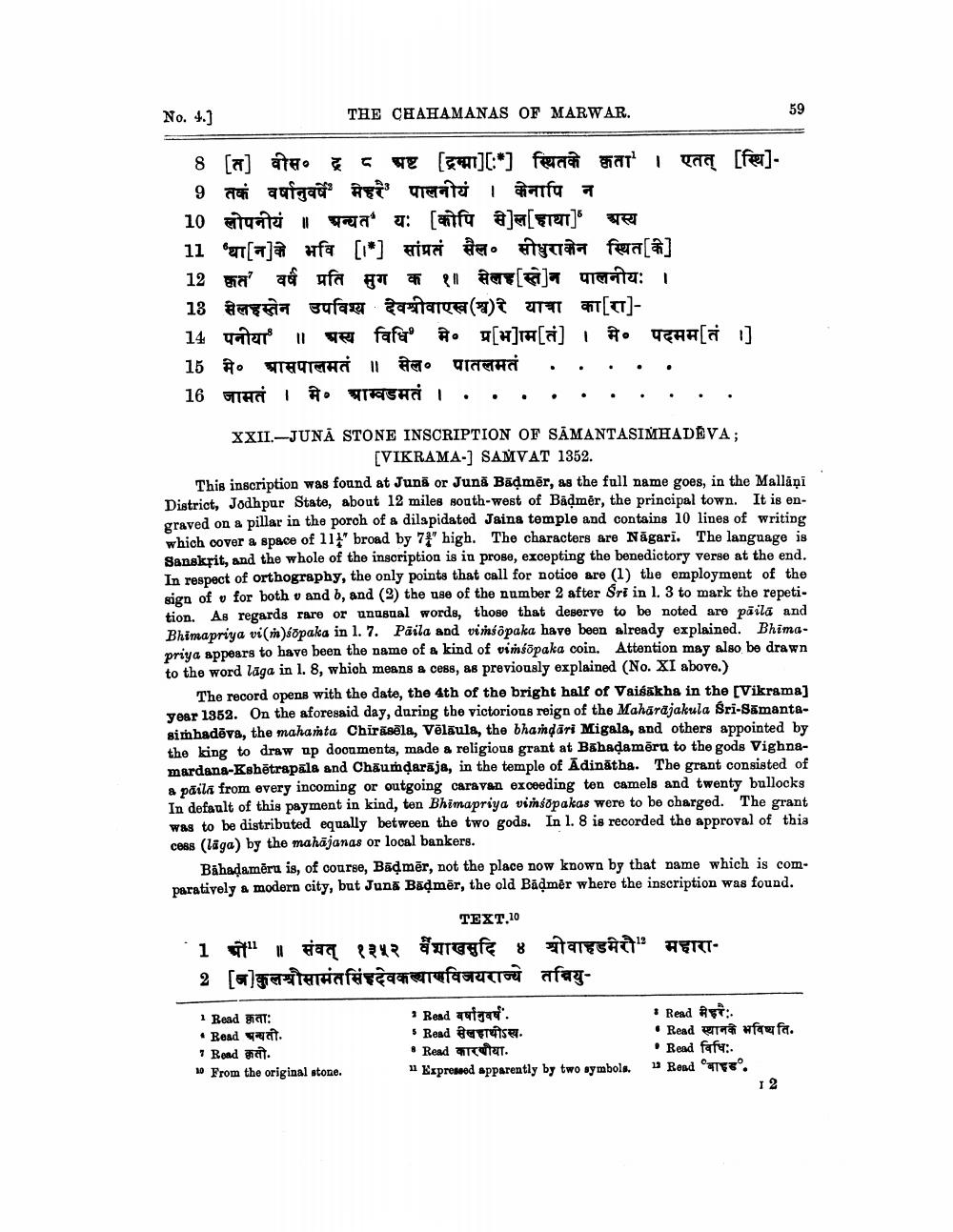________________
THE CHAHAMANAS OF MARWAR.
No. 4. J
9
०
8 [त] बीस० तकं वर्षानुवर्षे मेहरे' पालनीयं 10 लोपनीयं ॥ अन्यत' यः [कोपि 11 'बा[न] भवि [["] सांप्रतं सेल 12 त वर्ष प्रति सुग क | सेलर [स्ते] न १॥ 18 सेलहस्तेन उपविश्य देवश्रीवास्ख ( श्व) रे यात्रा 14 पनीया ॥ अस्य विधि' मे० प्र[भ]ाम [तं] 15 मे० आसपालमतं ॥ सेल० पातलमतं 16 जातं मे चापडतं ।
०
८ अष्ट [द्रमा][: *] स्थितके कृता । एतत् [स्थि] - । केनापि न
से ] ल [ हाथा ] " अस्य
•
सीधुराजेन स्थित [३] पालनीयः ।
का [ रा ]
।
1 Read कृता:
• Read अन्यतो.
7 Road छतो.
10 From the original stone.
·
मे० पदमम [तं ।]
XXII. - JUNĀ STONE INSCRIPTION OF SĀMANTASIMHADEVA; [VIKRAMA] SAMVAT 1352.
This inscription was found at Juna or Junā Bāḍmēr, as the full name goes, in the Mallāņi District, Jodhpur State, about 12 miles south-west of Baḍměr, the principal town. It is engraved on a pillar in the porch of a dilapidated Jaina temple and contains 10 lines of writing which cover a space of 111" broad by 7" high. The characters are Nagari. The language is Sanskrit, and the whole of the inscription is in prose, excepting the benedictory verse at the end. In respect of orthography, the only points that call for notice are (1) the employment of the sign of v for both v and b, and ( 2 ) the use of the number 2 after Sri in 1. 3 to mark the repetition. As regards rare or unusual words, those that deserve to be noted are paila and Bhimapriya vi(m)sopaka in 1. 7. Päila and vinsopaka have been already explained. Bhimapriya appears to have been the name of a kind of vimsopaka coin. Attention may also be drawn to the word lāga in 1. 8, which means a cess, as previously explained (No. XI above. )
The record opens with the date, the 4th of the bright half of Vaisakha in the [Vikrama] year 1352. On the aforesaid day, during the victorious reign of the Maharajakula Sri-Samantasimhadeva, the mahamta Chirasela, Velaula, the bhamḍāri Migala, and others appointed by the king to draw up documents, made a religious grant at Bahaḍamēru to the gods Vighnamardana-Kshetrapala and Chaumḍaraja, in the temple of Adinatha. The grant consisted of a päilä from every incoming or outgoing caravan exceeding ten camels and twenty bullocks In default of this payment in kind, ten Bhimapriya vimsopakas were to be charged. The grant was to be distributed equally between the two gods. In 1. 8 is recorded the approval of this cess (lāga) by the mahājanas or local bankers.
59
Bahaḍamēru is, of course, Baḍmēr, not the place now known by that name which is comparatively a modern city, but Jună Baḍmēr, the old Bäḍmer where the inscription was found.
TEXT.10
1 ॥ संवत् १२५२ वैशाखमुदि ४ श्रीबाडमेरो" महारा औ"
2 [r] कुलश्रीसामंत सिंह देवकल्याणविजयराज्ये तत्रियु
2 Rend वर्षानुवर्ष
• Road से हाथोऽस्य.
• Rend कारणौया.
11
Expressed apparently by two symbols.
Read
:
• Read स्थानके भविष्यति.
• Read विधि:.
22 Read बाइड'.
I 2




